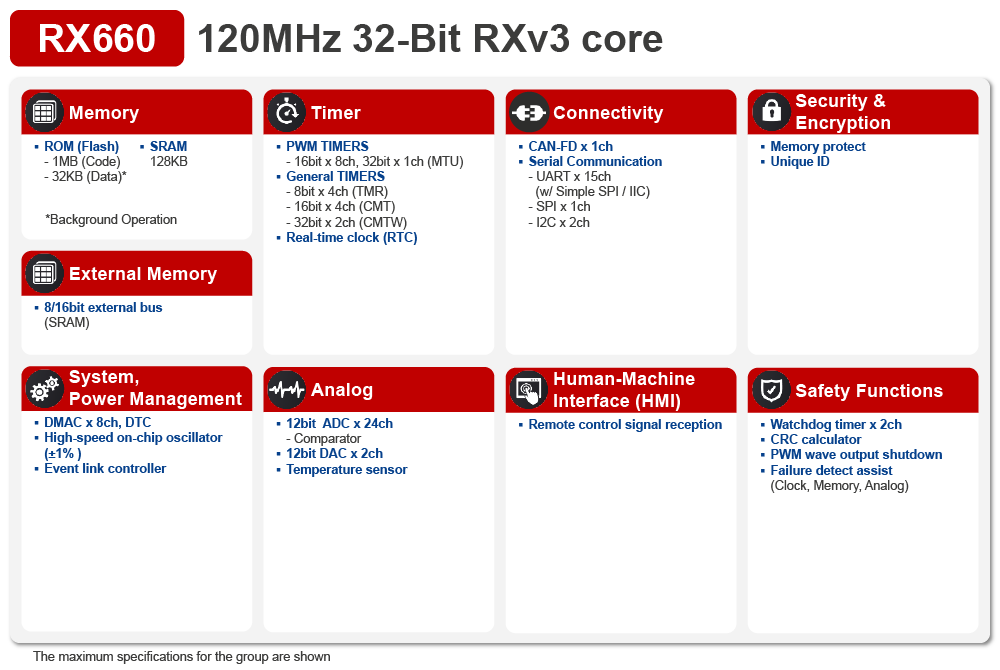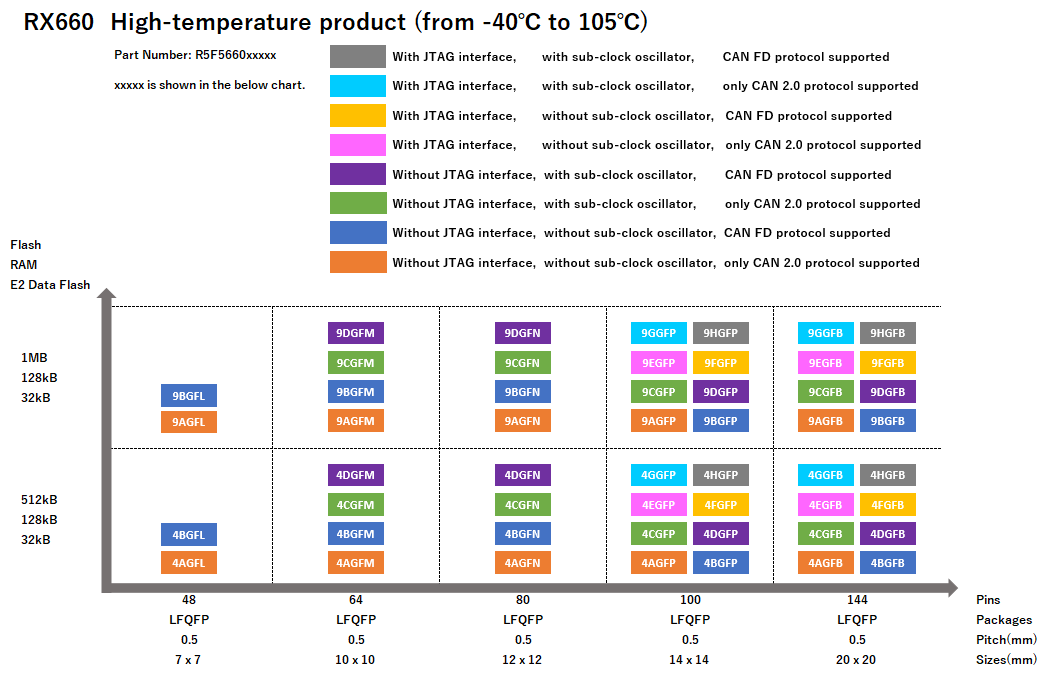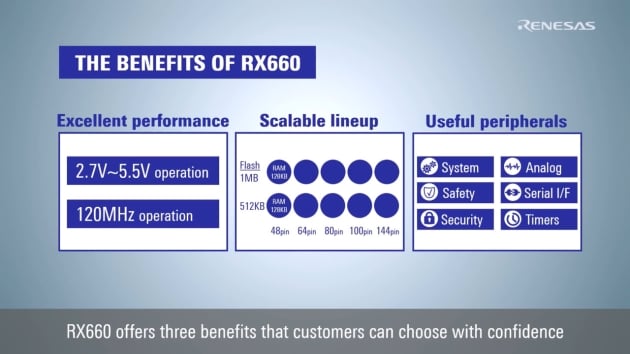Features
- 120MHz RXv3 core (6.01 CoreMark/MHz*), single-precision FPU, and register bank save function that speeds up interrupt response
- *Typical for RXv3 core
- Trigonometric calculators (sin, cos, arctan, hypot) to speed up motor vector control
- Wide operating voltage range of 2.7 to 5.5V
- Operating temperature: -40°C to 85°C or -40°C to 105°C
- Large-capacity memory: 1MB code flash, 128KB SRAM
- 32KB data flash that can store data like an EEPROM
- Diverse package lineup from 48 to 144 pins
- Up to 134 general-purpose I/O ports
- CAN FD (ISO 11898-1:2015 compliant, up to 5Mbps transfer)
- Infrared remote control receiver circuit
- Various other communication interfaces (SCI, IIC, RSPI, etc.)
- 16-bit PWM timer, 16-bit/32-bit compare match timer, 8-bit timer, RTC
- 12-bit A/D converter, temperature sensor
- Flash memory protection
- +/-1.0% accuracy high-speed on-chip oscillator
- Pin layout is compatible with existing RX products, peripheral function compatible
Description
The RX660 Group is the first 5V-compatible product among the RX600 and RX700 high-end general-purpose microcontrollers. With this 5V support, it gives excellent noise tolerance and does not require any external coils for noise suppression, which contribute to the reduction of the overall system cost. The RXv3 core operates at 120 MHz with no wait access to the flash memory, resulting in stable arithmetic processing and achieving excellent real-time performance. The number of effective general-purpose IO pins has been increased by approximately 10% from the previous 5V-compatible RX210, enabling an increase in the number of sensors that can be connected with the same package, contributing to easier system upgrades. For peripheral functions, this is the first in the RX series to incorporate CAN FD, enabling the implementation of next-generation networks such as industrial networks. Furthermore, HOCO oscillation accuracy of 1.0% can be guaranteed in a high-end product for the first time, enabling a reduction in external oscillators and contributing to lower system costs. A wide range of customer platform development can be handled with a single chip with a LFQFP package lineup ranging from 48-pin to 144-pin, and featuring up to 1MB flash memory and 128KB SRAM. This easily improves the performance and expands the functionality of home appliances and industrial equipment.
Parameters
| Attributes | Value |
|---|---|
| Main CPU | RXv3 |
| Program Memory (KB) | 512, 1024 |
| RAM (KB) | 128 |
| Carrier Type | Full Carton (Tray), Tray |
| Supply Voltage (V) | 2.7 - 5.5 |
| I/O Ports | 40, 54, 56, 70, 72, 89, 90, 91, 92, 131, 132, 133, 134 |
| DRAM I/F | No |
| Temp. Range (°C) | Tj = -40 to +105, Tj = -40 to +125 |
| Operating Freq (Max) (MHz) | 120 |
| Ethernet speed | No |
| Ethernet (ch) | 0 |
| EtherCat (ch) (#) | 0 |
| USB FS (host ch/device ch) | ( 0 / 0 ) |
| USB HS (host ch/device ch) | ( 0 / 0 ) |
| USB SS (host ch/device ch) | ( 0 / 0 ) |
| SCI or UART (ch) | 9, 12, 13, 14, 15 |
| SPI (ch) | 10, 13, 14, 15, 16 |
| I2C (#) | 10, 13, 15, 16, 17 |
| CAN (ch) | 0, 1 |
| CAN-FD (ch) | 0, 1 |
| Wireless | No |
| SDHI (ch) | 0 |
| High Resolution Output Timer | No |
| PWM Output (pin#) | 21, 24 |
| 32-Bit Timer (ch) | 2, 3 |
| 16-Bit Timer (ch) (#) | 11, 12 |
| 8-Bit Timer (ch) | 3, 4 |
| Standby operable timer | No |
| 12-Bit A/D Converter (ch) | 10, 14, 17, 24 |
| 24-Bit Sigma-Delta A/D Converter (ch) | 0 |
| 16-Bit D/A Converter (ch) | 0 |
| 12-Bit D/A Converter (ch) | 2 |
| 8-Bit D/A Converter (ch) | 0 |
| Capacitive Touch Sensing Unit (ch) | 0 |
| Segment LCD Controller | No |
| Security & Encryption | Unique ID |
Application Block Diagrams

|
High-Efficiency Online Uninterruptible Power Supply (UPS) with Real-Time Monitoring
Online UPS ensures uninterrupted power with real-time monitoring, advanced power management, and efficiency.
|
Applied Filters:
Filters
Software & Tools
Sample Code
Simulation Models
This video explains the newly designed RX660 voice recognition solution, including board information, relevant tools, and evaluation results in an environment that appears in daily life.
Learn more about RX660 MCU which is the first general-purpose microcontroller to deliver superior noise tolerance for 5V power supply. RX660 enables scaling of development by increasing the effective number of GPIO pins by 10% compared to RX210. Also, the embedded CAN FD controller enables high-speed and large-volume data communication facilitating real-time control between devices.







